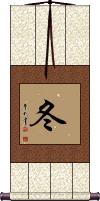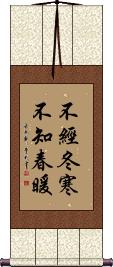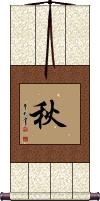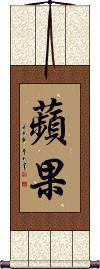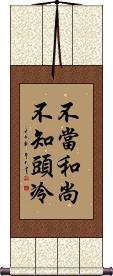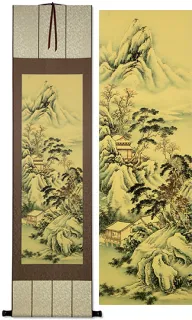Many custom options...
And formats...

Winter in Chinese / Japanese...
Buy a Winter calligraphy wall scroll here!
Personalize your custom “Winter” project by clicking the button next to your favorite “Winter” title below...
Winter Season
冬 is the word/character used to describe the Winter season in Chinese and Japanese.
It also means winter in Korean Hanja, though a second character is usually added in Korean.
You must endure a harsh winter to appreciate the warmth of springtime
You must know hardship to appreciate happiness
This literally translates as: Without having experienced the cold of winter, one cannot appreciate the warmth of spring.
Figuratively, this means: One cannot truly appreciate happiness without having gone through hardship.
There are many contrasts in life. One simply cannot fully know what joy is without having experienced misery, difficulty, and pain. How could you explain “light” if you did not have “darkness” to compare it to?
Embrace hardship, as it makes the good times seem even better.
Autumn / Fall Season
秋 is the word/character used to describe the Autumn or Fall season in Chinese and Japanese.
See Also: Spring | Summer | Four Seasons
The Four Seasons
春夏秋冬 is one way to express “The Four Seasons “ or “All Year Round “.
The characters here represent Spring, Summer, Autumn (Fall), and Winter.
Apple
To Know Hardship, One Must Experience It
不當和尚不知頭冷 is a Chinese proverb that literally translates as: [One who has] not been a monk [does] not know [the feeling of a] cold head.
I need to explain that a Chinese Buddhist monk always has a shaved head, and thus a cold head in winter.
Figuratively, this means: One cannot know the true meaning of hardship until one has experienced it oneself.
This is an idiom in Chinese, so the figurative meaning is what people perceive when they hear or read this phrase. Just as in English, when someone says, "The grass is always greener," one will think about the idea of jealousy, rather than the quality of one’s lawn.
This in-stock artwork might be what you are looking for, and ships right away...
Gallery Price: $83.00
Your Price: $45.88
Gallery Price: $83.00
Your Price: $45.88
Gallery Price: $220.00
Your Price: $79.88
Gallery Price: $220.00
Your Price: $79.88
Gallery Price: $220.00
Your Price: $79.88
Gallery Price: $100.00
Your Price: $45.88
These search terms might be related to Winter:
Not the results for winter that you were looking for?
Below are some entries from our dictionary that may match your winter search...
| Characters If shown, 2nd row is Simp. Chinese |
Pronunciation Romanization |
Simple Dictionary Definition |
冬 see styles |
dōng dong1 tung fuyu ふゆ |
More info & calligraphy: Winter Season(n,adv) winter; (female given name) Fuyu hima; hemanta; winter. |
四季 see styles |
sì jì si4 ji4 ssu chi shiki しき |
More info & calligraphy: The Four Seasonsthe four seasons; (female given name) Yomogi |
春夏秋冬 see styles |
chūn xià qiū dōng chun1 xia4 qiu1 dong1 ch`un hsia ch`iu tung chun hsia chiu tung shunkashuutou / shunkashuto しゅんかしゅうとう |
More info & calligraphy: The Four Seasons(n,adv) (yoji) spring, summer, autumn (fall) and winter; the four seasons; (personal name) Hitotose |
柞 see styles |
zuò zuo4 tso nara なら |
oak; Quercus serrata (kana only) oak (esp. Quercus serrata); Distylium racemosum (evergreen tree of the winter-hazel genus); (personal name) Nara |
榎 see styles |
jiǎ jia3 chia enoki えのき |
(evergreen shrub); Celtis sinensis (1) (kana only) Japanese hackberry (Celtis sinensis var. japonica); Chinese nettle tree; (2) (kana only) (abbreviation) enoki mushroom (Flammulina velutipes); winter mushroom; velvet shank; enokitake; enokidake; (surname) Enoki |
狩 see styles |
shòu shou4 shou kari かり |
to hunt; to go hunting (as winter sport in former times); hunting dog; imperial tour (1) hunting; (n,n-suf) (2) harvesting (e.g. berries, fruit); picking; gathering; (surname) Kari |
臘 腊 see styles |
là la4 la rou / ro ろう |
ancient practice of offering sacrifices to the gods in the 12th lunar month; the 12th lunar month; (bound form) (of meat, fish etc) cured in winter, esp. in the 12th lunar month (1) {Buddh} offering ceremony held on the third day of the dog after the winter solstice; (2) twelfth month of the lunisolar calendar; (3) (See 臈) year in the Buddhist order (after the completion of the first meditation retreat) Dried flesh; to sacrifice to the gods three days after the winter solstice; the end of the year; a year; a monastic year, i.e. the end of the annual summer retreat, also called 戒臘; 夏臘; 法臘. |
三冬 see styles |
santou / santo さんとう |
three winter months; (female given name) Mifuyu |
三季 see styles |
sān jì san1 ji4 san chi miki みき |
(female given name) Miki The "three seasons" of an Indian year— spring, summer, and winter; a year. |
中夜 see styles |
zhōng yè zhong1 ye4 chung yeh chuuya / chuya ちゅうや |
(1) {Buddh} (See 六時) midnight period; midnight service; (2) (archaism) winter solstice; (surname) Nakaya midnight |
二至 see styles |
nishi にし |
the two solstices (summer and winter) |
交九 see styles |
jiāo jiǔ jiao1 jiu3 chiao chiu |
the coldest period of the year; three nine day periods after the winter solstice |
今冬 see styles |
kontou / konto こんとう |
(n,adv) this winter; next winter; last winter |
余寒 see styles |
yokan よかん |
lingering winter |
六時 六时 see styles |
liù shí liu4 shi2 liu shih rokuji ろくじ |
(1) six o'clock; (2) (Buddhist term) six periods of a day (morning, midday, afternoon, evening, midnight, late night) The six 'hours' or periods in a day, three for night and three for day, i. e. morning noon, evening; night, midnight, and dawn. Also, the six divisions of the year, two each of spring, summer, and winter. |
冬令 see styles |
dōng lìng dong1 ling4 tung ling |
winter; winter climate |
冬作 see styles |
fuyusaku ふゆさく |
winter crop |
冬型 see styles |
fuyugata ふゆがた |
(1) (abbreviation) (See 冬型気圧配置) atmospheric pressure pattern in winter; winter pressure pattern; (can be adjective with の) (2) wintery; characteristic of winter |
冬場 see styles |
fuyuba ふゆば |
wintertime; winter season |
冬夏 see styles |
dōng xià dong1 xia4 tung hsia fuyuka ふゆか |
winter and summer (female given name) Fuyuka |
冬夜 see styles |
dōng yè dong1 ye4 tung yeh touya / toya とうや |
(female given name) Touya The night before the 冬至 winter solstice. |
冬天 see styles |
dōng tiān dong1 tian1 tung t`ien tung tien touten / toten とうてん |
winter; CL:個|个[ge4] winter sky; wintry weather |
冬季 see styles |
dōng jì dong1 ji4 tung chi touki / toki とうき |
winter (season of) winter; (personal name) Fuyuki |
冬宮 冬宫 see styles |
dōng gōng dong1 gong1 tung kung toukyuu / tokyu とうきゅう |
Winter Palace (St Petersburg); Hermitage Museum (place-name) Winter Palace (in Saint Petersburg); Zimniy Dvorets |
冬尺 see styles |
fuyushaku; fuyushaku ふゆしゃく; フユシャク |
(kana only) winter moth (Geometridae spp.) |
冬山 see styles |
dōng shān dong1 shan1 tung shan fuyuyama ふゆやま |
Dongshan or Tungshan Township in Yilan County 宜蘭縣|宜兰县[Yi2 lan2 Xian4], Taiwan (1) wintry mountain; (2) mountain that is popular for climbing in winter; (surname) Fuyuyama |
冬日 see styles |
fuyubi ふゆび |
(1) winter sun; winter sunshine; (2) day on which the temperature drops below 0°C; below-freezing day |
冬會 冬会 see styles |
dōng huì dong1 hui4 tung hui fuyue |
winter assembly |
冬月 see styles |
dōng yuè dong1 yue4 tung yüeh tougetsu / togetsu とうげつ |
eleventh lunar month (1) winter; winter season; (2) winter moon; (female given name) Fuyutsuki |
冬服 see styles |
fuyufuku ふゆふく |
winter clothing |
Click here for more winter results from our dictionary
The following table may be helpful for those studying Chinese or Japanese...
| Title | Characters | Romaji (Romanized Japanese) | Various forms of Romanized Chinese | |
| Winter Season | 冬 | fuyu | dōng / dong1 / dong | tung |
| You must endure a harsh winter to appreciate the warmth of springtime | 不經冬寒不知春暖 不经冬寒不知春暖 | bù jīng dōng hán bù zhī chūn nuǎn bu4 jing1 dong1 han2 bu4 zhi1 chun1 nuan3 bu jing dong han bu zhi chun nuan | pu ching tung han pu chih ch`un nuan pu ching tung han pu chih chun nuan |
|
| Autumn Fall Season | 秋 | aki | qiū / qiu1 / qiu | ch`iu / chiu |
| The Four Seasons | 春夏秋冬 | shunkashuutou shunkashuto | chūn xià qiū dōng chun1 xia4 qiu1 dong1 chun xia qiu dong chunxiaqiudong | ch`un hsia ch`iu tung chunhsiachiutung chun hsia chiu tung |
| Apple | 蘋果 苹果 | píng guǒ / ping2 guo3 / ping guo / pingguo | p`ing kuo / pingkuo / ping kuo | |
| To Know Hardship, One Must Experience It | 不當和尚不知頭冷 不当和尚不知头冷 | bù dāng hé shàng bù zhī tóu lěng bu4 dang1 he2 shang4 bu4 zhi1 tou2 leng3 bu dang he shang bu zhi tou leng | pu tang ho shang pu chih t`ou leng pu tang ho shang pu chih tou leng |
|
| In some entries above you will see that characters have different versions above and below a line. In these cases, the characters above the line are Traditional Chinese, while the ones below are Simplified Chinese. | ||||
Successful Chinese Character and Japanese Kanji calligraphy searches within the last few hours...
